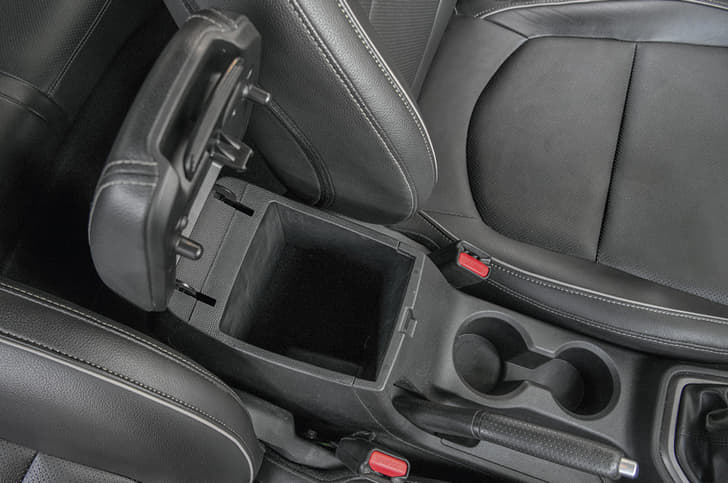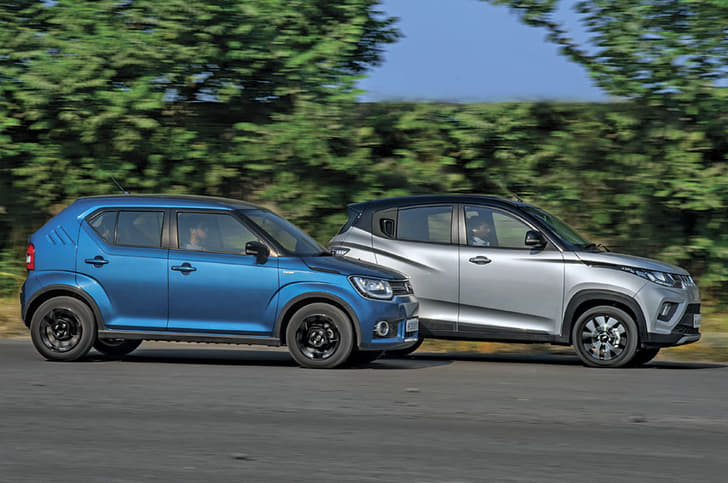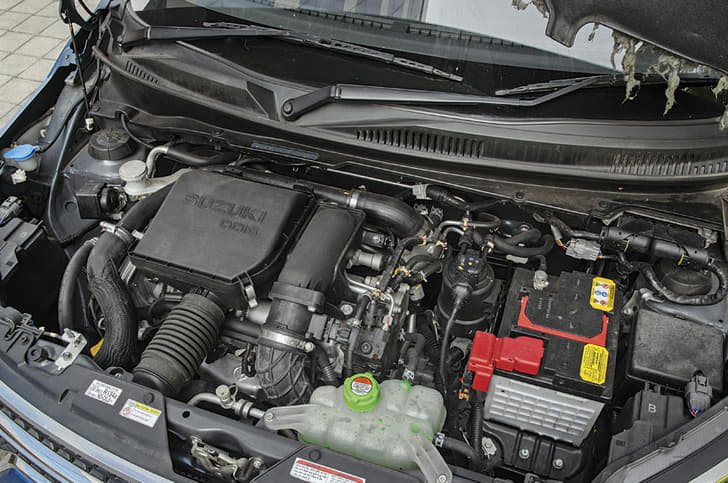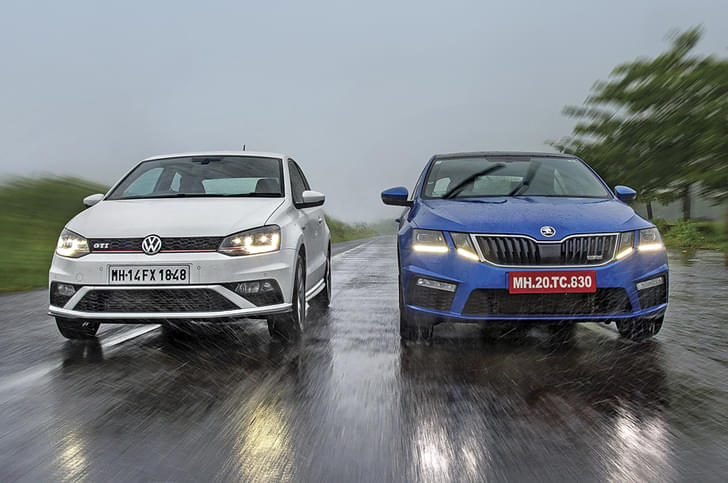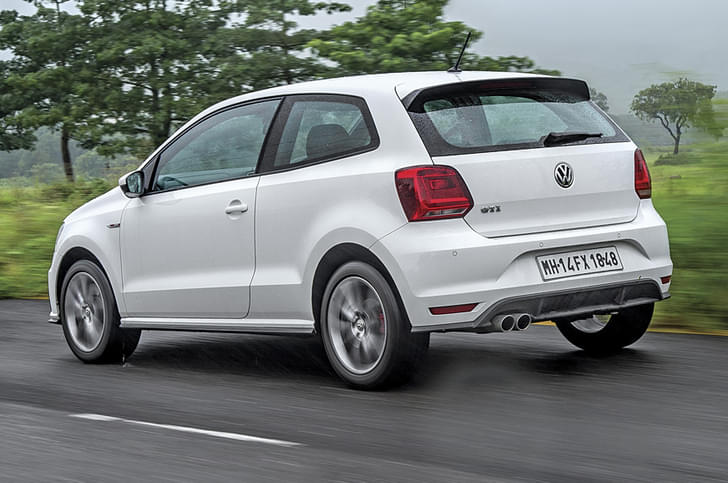You have to hand it to Renault for the way it has priced the new Captur. With prices starting at Rs 9.99 lakh (ex-showroom, Delhi) for the base petrol version and topping off at Rs 14.06 lakh for the fully loaded diesel, the Captur costs a good few lakh rupees less than everyone expected it to. Forget being priced close to the Jeep Compass, the Captur even undercuts the Hyundai Creta and there’s even some overlap with Renault’s own Duster – and this should explain why we’ve brought together the SUVs we have here.
We’ve picked the top-spec diesel (manual) versions of the three models, which also means the Duster in consideration is in AWD form. This particular version’s all-wheel drive hardware and independent rear suspension not only make it the most wholesome of the Dusters on offer, but also give it a mechanical edge or two over the Captur and Creta. The Duster 110PS RxZ AWD is Rs 1 lakh costlier than the similar-specced front-wheel drive version, but, even so, the AWD’s Rs 12.79 lakh price tag makes it the most affordable SUV here. At the other extreme is the Creta 1.6 CRDi SX(O) that comes in at Rs 14.48 lakh. Pricey? Yes. But this hasn’t stopped the Creta from becoming a sales sensation, as far as SUVs go. The Captur Platine diesel slots in right between the two rivals on price.
There are, as ever, burning questions to be answered. Is the Captur more than just a Duster in a fancy suit? Is the Creta still good enough to warrant its high price? And could the Duster AWD be all the SUV you need? And of, course, the big one – which is the SUV to buy? Time to get to work.
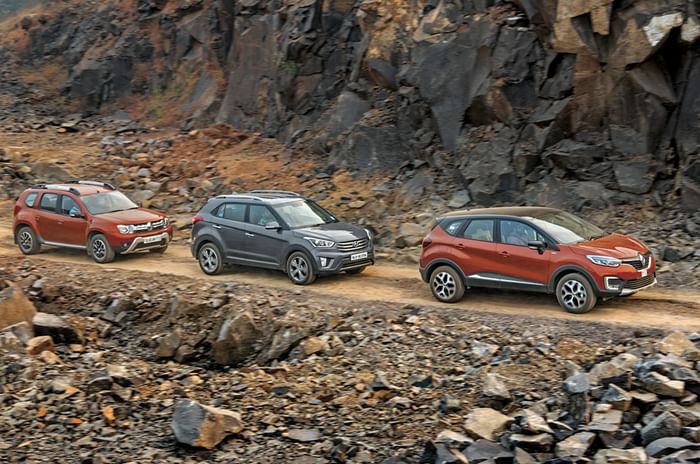
OF SHAPES AND SIZES
The three models do come under the broad umbrella of the SUV body style; but even then, traditionalists might find the Captur takes things a bit too far with a design that is decidedly crossover. The look does divide opinion but those who take keenly to its swoopy shape are sure to see it as a modern Renault you’d find on the streets of any large city in Europe. Interestingly, the Captur for India doesn’t share its underpinnings with the Clio like its near-identical Euro-spec sibling. Instead, it is built on Renault’s hardy M0 platform that also forms the basis of the Duster. The last bit partly explains why the India-made Captur and Duster have an identical wheelbase. The Captur is, however, marginally longer than the Duster and, by extension, the Creta, too.
Also, while the Captur has the lowest roofline of the trio, it matches the Duster AWD on ground clearance – a considerable 210mm versus the Creta’s 190mm. All-in-all,the Captur has a chunky, squat stance and looks quite substantial in the metal. Its stylish 17-inch alloy wheels fill the large wheel arches well. There’s a nice use of cladding on the lower portion of the body and the front and rear scuff plates really don’t seem out of place either. Renault is also pushing the Captur’s lighting package – and rightfully so. Ripple-effect LED tail-lamps and ‘C’-shaped daytime running LEDs aside, the Captur also boasts full LED headlights that are a segment- first feature. They provide excellent illumination at night and also come with indicators that swipe in the direction of the turn, much like those on the latest Audis. Do note you can also jazz up the look with everything from a contrast roof and roof graphics to body stickers and chrome embellishments.
Hyundai, too, has toyed with the idea of a dual-tone paint scheme for the Creta (available only on the second from the top SX+ trim for now) but more significant visual updates are expected when the proper facelift comes out in mid-2018. That’s not to say the current Creta looks haggard; far from it. The Creta remains a smart-looker with many styling elements. Of course, what continues to work in Hyundai’s favour is its upright stance; something that many buyers associate with proper SUVs.
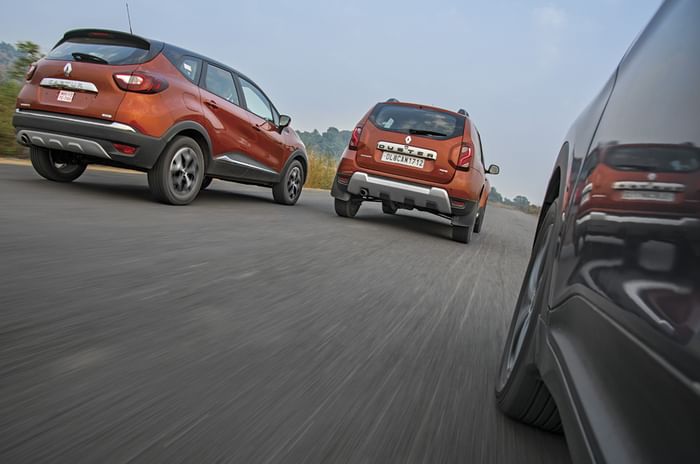
The Duster has been around in India the longest (launched in 2012), and despite a refresh in 2016, the Renault SUV has started looking its age. What’s accelerated the ageing process, of late is the reveal of the new-gen Duster, abroad. Still, the current model has its own charm, with an honest and no-nonsense air about it. The simple lines, the accentuated flanks and muscular look work to this day, but touches like projector headlamps and daytime-running LEDs would have kept the Duster with the times. As would pull-type door handles in place of the tacky lift-type units.
| Dimensions | |||
|---|---|---|---|
| Renault Captur Platine | Hyundai Creta 1.6 CRDi SX(O) | Renault Duster 110PS AWD RXZ | |
| Length | 4329mm | 4270mm | 4315mm |
| Width | 1813mm | 1780mm | 1822mm |
| Height | 1619mm | 1630mm | 1696mm |
| Wheelbase | 2673mm | 2590mm | 2673mm |
| Kerb weight | 1375kg | 1350kg | 1421kg |
OF LOOK AND FEEL
Enter the Captur’s cabin and you’ll like what you see, at least at first glance. The Platine edition’s quilted leather seats look genuinely premium, the dual-tone dashboard has an interesting layout, and even the butterfly-look instrument cluster with the digital speedo is unique. Pearl-finish plastics on the doors also help the look, though we aren’t quite taken by the dull-gold interior detailing (around the air-con vents and centre console) exclusive to Platine edition cars. Our bigger grouse is with the hard plastics that the dashboard comes finished in; that just drags things down. Not to be overly critical but there are a few other bugbears as well. The glovebox is narrow, the driver’s footwell is tight (there’s no dead pedal) and the fixed front centre armrest can foul with your arm when using the handbrake. Also, while front seat comfort is good, taller drivers will find themselves sitting too high even at the seat’s lowest position, giving a less than ideal view of the road.
In comparison, the Creta’s cabin comes across as better thought out. It not only offers the most storage spaces and best ergonomics but there’s also a greater harmony in the choice of materials. Fit and finish is easily the best, here and that feeling of quality is pervasive, extending down to the switches and stalks too. The Creta’s two-tone dashboard is also neat and clean, and the high-set touchscreen is easy to access and further underlines the user-friendly nature of this cabin. Drivers will find the top-spec Creta’s nicely finished leather seats to be well-positioned and comfortable, even if a bit soft, on long drives.
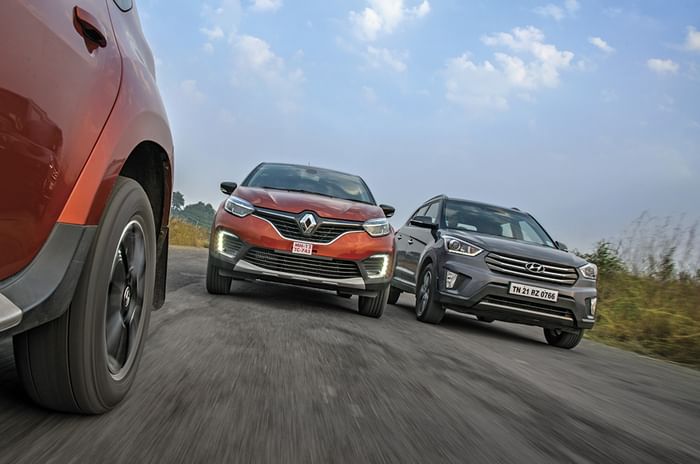
After spending time in the Captur and Creta, you’ll have to be very benevolent to have nice things to say about the Duster’s cabin. Frankly, the dashboard looks rudimentary and material quality is just average by latest standards. Of the other things, the touchscreen is positioned too low for handy access, and things like the driver’s seat height adjust are just too utilitarian. Leather seats are not part of the package either, but the flat front seats do offer a fair amount of support.
OF GADGETS AND GIZMOS
Before we jump into the goodies these cars come with, a crucial word first on safety. All three models come with anti-lock brakes and dual airbags as standard, though only the Captur offers Isofix child seat mounts across the range. The fully loaded versions of the SUVs, as featured here, commendably add in Electronic Stability Control and Hill Start Assist. Capturs in Platine trim further get side airbags – but it’s the Creta SX(O) that goes one up on the Renault with the inclusion of curtain airbags, too.
As for creature comforts, all three SUVs come with auto climate control, steering audio controls and reverse cameras. However, only the Creta loses out on cruise control, while the Duster trails the others by missing out on leather seats, keyless go (the Captur is unique for its card-shaped key) and rear air-con vents. As mentioned already, the Captur is the only model here with LED headlights but it’s also the only one to come with LED cabin lamps, auto headlights and auto wipers.
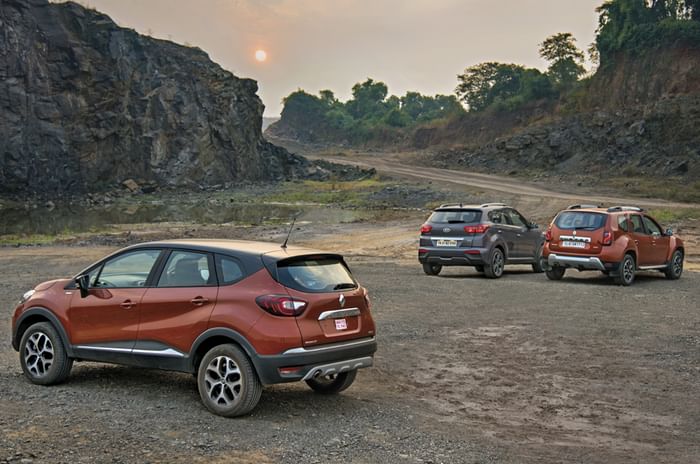
The Creta does score a crucial victory in the area of in-car entertainment with its 7.0-inch touchscreen-operated system coming factory-fit with Android Auto and Apple CarPlay. The touchscreen is also the nicest to use here. The Captur uses the latest version of Renault’s touchscreen interface, and is slicker and more responsive than the older unit that continues to do duty on the Duster, Lodgy and Kwid.
| Equipment | |||
|---|---|---|---|
| Renault Captur Platine | Hyundai Creta 1.6 CRDi SX(O) | Renault Duster 110PS AWD RXZ | |
| LED headlights | Yes | NA | NA |
| Auto headlights/wipers | Yes | NA | NA |
| Keyless go | Yes | Yes | NA |
| Leather seats | Yes | Yes | NA |
| Touchscreen infotainment system | Yes | Yes | Yes |
| Apple CarPlay/Android Auto | NA | Yes | NA |
| Cruise control | Yes | NA | Yes |
| Reversing camera | Yes | Yes | Yes |
| Rear AC vents | Yes | Yes | NA |
| Airbags | 4 | 6 | 2 |
OF SPACE AND PRACTICALITY
Given that the Creta has the smallest wheelbase and is also the shortest in overall length, you’d expect it to offer the least space in the back, right? Well, you are in for a pleasant surprise. The Creta is actually the roomiest with significantly more legroom than either Renault. The rear seat is quite nice too, but the way it’s been bolstered makes it amply clear this is a space Hyundai intended for two rather than three. Also, the rising window line means those sitting at the back don’t quite get the panoramic view they’d want out of an SUV.
The Captur has its own peculiarities. A high door sill means you have to lift your feet quite high up to enter the cabin; and those seated at the back will also find the large front seats to restrict the view out the front. Rear seat space is decent, not great, but the seat itself is well-cushioned and can accommodate three at a pinch.
The Duster matches the Captur on rear legroom and shoulder room but has the advantage of larger windows that afford a better view out. Also note, while the Duster’s rear seats may look very basic in contour, they are actually surprisingly supportive.
There’s not too much difference here in terms of luggage-carrying capacity. Going solely by the numbers, the Duster AWD’s 410-litre boot is the largest and the Captur’s 392-litre space is the smallest. But it’s the Creta whose 402-litre boot offers the most usable space. All three SUVs allow you to fold the single-piece rearseat backrests to make more space. Worth a mention is the fact that the Captur positions its spare wheel under the body rather than in the boot.
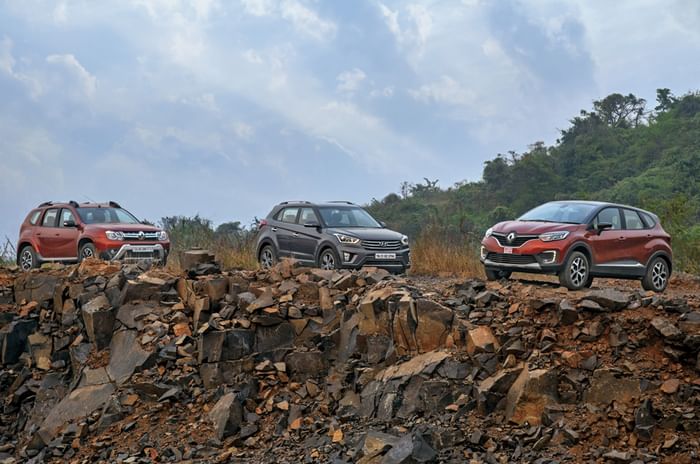
OF POWER AND PERFORMANCE
Do a brochure-to-brochure comparison and you’ll be convinced the Creta is the best performing of the three SUVs. It’s 128hp and 260Nm, 1.6-litre diesel engine is the strongest here, and the Creta is also the lightest of the models. Put to the test, it did prove to be the quickest from 0-100kph with a commendable time of 10.81sec. In the more relevant in-gear timings, though, the Creta was outdone by its rivals. The thing is, the engine comes into its element past 1,800rpm, so there’s some waiting before you get to the good stuff. The lag is not as accentuated as on something like the old Maruti S-cross 1.6, and you can roll along comfortably at lower speeds. It’s just that the Renaults provide readier access to power. However, when you do press on, it’s the Creta’s engine that comes across as the most free-revving; it comfortably revs to its 5,000rpm limiter. A smooth-shifting six-speed gearbox and reasonably light clutch make the driving experience that little bit nicer.
The Captur and Duster come powered by the same 1.5-litre diesel engine but there are minute differences in power and torque outputs. On both SUVs, the engine makes 110hp but does so at 3,850rpm on the Captur, and 4,000rpm on the Duster AWD. Also, the Duster AWD’s 245Nm max torque figure is 5Nm more than the Captur’s, though both are produced at the same 1,750rpm. Both Renaults also come with six-speed gearboxes, but the major difference is that the Duster uses significantly shorter gearing, incorporated to meet the low-speed torque requirements in off-roading. As a happy consequence, the gearing has blessed this version of the Duster with brilliant tractability in town. The Duster AWD is quicker than the Creta and Captur through every gear; and how. The difference in acceleration from 20-40kph in third gear or 80-100kph in sixth gear is in seconds, and not mere milliseconds! The Duster AWD is in its comfort zone by all of 1,500rpm minimizing the need to work the slightly notchy gearbox all that often. Given that the engine also gets quite loud when revved, it’s best to keep it running in the lower half of the rev band.
Viewed in isolation, the Captur too scores well for real-world performance; but the 1.5-litre engine doesn’t feel quite as flexible in this application. You have to pay more attention to the gear you are in (you’ll have to contend with the slightly springy clutch too) because the Captur bunches up power for release at about 1,700rpm. The engine pulls strongly, then on and will rev to 4,800rpm and beyond, if required. That being said, the Captur is best enjoyed in the mid-range where the ample grunt comes into play to make the Renault an able cruiser. Oh, and the Captur is also rather quiet when on the go. It recorded the lowest noise levels at 80kph in sixth gear and 50kph in fourth gear.
| Powertrain and performance | |||
|---|---|---|---|
| Renault Captur Platine | Hyundai Creta 1.6 CRDi SX(O) | Renault Duster 110PS AWD RXZ | |
| Engine | 4 cyls, 1461cc, turbo-diesel | 4 cyls, 1582cc, turbo-diesel | 4 cyls, 1461cc, turbo-diesel |
| Power | 110hp at 3850rpm | 128hp at 4000rpm | 110hp at 4000rpm |
| Torque | 240Nm at 1750rpm | 260Nm at 1900-2700rpm | 245Nm at 1750rpm |
| Gearbox | 6-speed manual | 6-speed manual | 6-speed manual |
| 0-20kph | 1.97s | 1.14s | 0.84s |
| 0-40kph | 3.83s | 2.50s | 2.77s |
| 0-60kph | 5.90s | 4.40s | 5.28s |
| 0-80kph | 9.01s | 7.24s | 8.68s |
| 0-100kph | 13.10s | 10.81s | 12.83s |
| 0-120kph | 18.93s | 15.33s | 19.52s |
| 20-80kph (in 3rd gear) | 10.46s | 11.52s | 9.08s |
| 40-100kph (in 4th gear) | 11.82s | 12.42s | 9.96s |
| Noise at idle | 47.9dB | 43.9dB | 48.8dB |
| Noise at 50kph in fourth gear | 60.8dB | 63.6dB | 64.3dB |
| Noise at 80kph in sixth gear | 63.9dB | 65.1dB | 67.1dB |
OF RIDE AND HANDLING
For long, we’ve rated the Duster AWD as the best-riding SUV in the segment. Things change with this comparison because the Captur sets the new benchmark in this department. There is a slight firmness to the damping but on the positive side, the Captur remains terrifically composed on even terrible patches of road. The ample clearance and wheel travel also up the confidence levels. Road holding, on the whole, is excellent and very premium European car-like. There is a slight heft to the Captur’s electro-hydraulic steering so it’s not the easiest to twirl at low speeds but on highways and twisty roads, you do get a good feeling of connect with the car. Turn-in is neat and body control quite good. Unfortunately, one of the ghosts of the original front-wheel Duster has come back to haunt the Captur. There’s plenty of kickback on rough roads, and you can even feel the steering do a jig on mid-corner bumps.
Steering kickback is less frequent and less severe on the Duster AWD, and the steering is lighter-weighted, too. You won’t have much reason to complain about this Duster’s ride quality, either. It makes light work of the roughest of roads but seen in light of the Captur, the Duster thuds that little bit more over the worst patches and doesn’t offer quite the same level of pliancy as its sibling. Still, its high-speed stability is good and its handling is tidy.
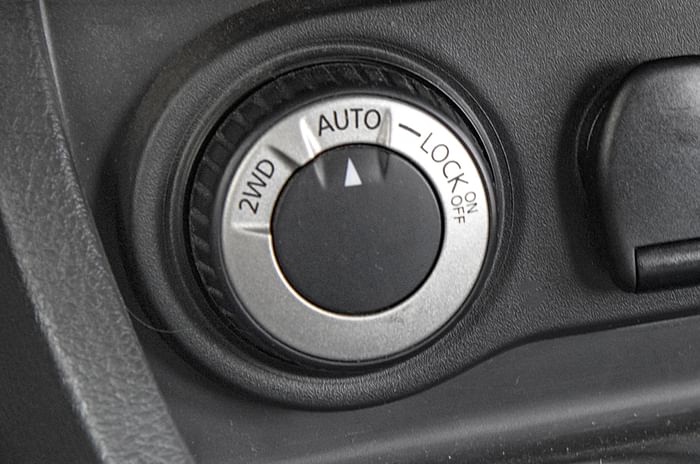
Drive the Hyundai on the same stretch of highway after a go in the Captur or Duster and you’ll immediately note how much ‘looser’ it feels. It’s not bad per se, and more than just acceptable, but the Renaults do highlight the Creta’s lesser points. There’s more body movement just about everywhere and you don’t get the same confidence at triple-digit speeds. Actually speaking, the Creta feels as if it’s engineered primarily for urban confines. It has the lightest of the steerings, and also rounds off the bumps at low speeds better than either Renault manages to.
These are SUVs so, of course, we’ll talk off-road ability too. The Creta is fine on mild off-road trails but we wouldn’t advise venturing too far away from tarmac in one. We were quite surprised by the Captur’s ability to claw its way up gravely hillocks and the like (in the dry), but if you want an all-weather companion for your adventures, you’ll be best off with the Duster AWD; its all-wheel drive system works really well when conditions get tricky.
OF WINNERS AND LOSERS
The Duster AWD wasn’t a favourite to win this contest and, unsurprisingly, it’s come in last. With the arrival of the new Captur, we really can’t think of too many reasons one would spend similar money for a Duster 110PS. The swankier Captur does most things better and has even walked away with the AWD version’s title of best-riding SUV in the segment. Peppy as it is, the Duster AWD, we envisage, will really only appeal to the few buyers with a genuine use for its all-wheel drive system.
The Creta, on the other hand, is on a far stronger wicket. Sales are consistently strong, and even two years after launch, the SUV has some solid draws. It’s the most spacious on here, its cabin is well-finished and comes with plenty of features too; but Hyundai has been consistently upping prices to the point we are now forced to be stricter in our judgment. The Creta could have been – scratch that – should have been better to drive to completely justify the high asking price.
In the final analysis, it’s the Captur that just comes across as most tempting. Sure, cabin quality is average and it’s not particularly spacious either, but for the justified money, you also get an SUV with stylish European looks backed by some rugged mechanicals. And there really are no two ways about which is the superior vehicle to drive. Pardon the cliché, then, because style and substance eventually win this contest for the Captur.
| Price, verdict and rating | |||
|---|---|---|---|
| Renault Captur Platine | Hyundai Creta 1.6 CRDi SX(O) | Renault Duster 110PS AWD RXZ | |
| Price (ex-showroom, Delhi) | Rs 14.06 lakh | Rs 14.48 lakh | Rs 12.79 lakh |
| Verdict | Not perfect but has the looks, build, ride and price to come up trumps. | Well-turned-out SUV has space and ease of use on its side. Pricey for what it offers, though. | Peppy in town and really good off-road, but you’d want much more from the package. |
| Rating | 8/10 | 8/10 | 7/10 |




